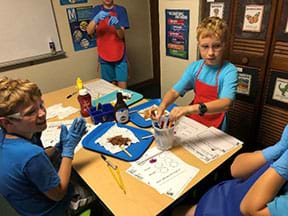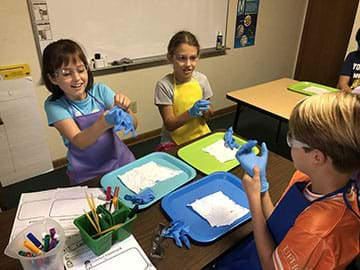Quick Look
Grade Level: 5 (4-6)
Time Required: 45 minutes
Lesson Dependency: None
Subject Areas: Biology, Chemistry, Life Science, Measurement, Physical Science
Summary
What do enzymes and engineering have in common? As a catalyst that creates a chemical reaction, enzymes are a unique substance that chemical engineers can learn from to create their own unique chemical designs. In this lesson, students learn about enzymes, study how enzymes work in our digestive system, and discuss enzymes are used in laundry detergents. Students relate to the idea that enzymes digest the food in the human body, and that enzymes can also be used to digest food stains on clothing.
Engineering Connection
Laundry is a real-world problem to which we can all relate. Engineers work to solve all types of problems, including how to create chemicals that help us in our daily lives. In the case of cleaning agents used in household products such as laundry detergent, chemical engineers use their knowledge of chemistry to engineer formulas. Engineers look to a variety of sources to solve problems and the human body is an excellent source of inspiration. For example, enzymes are present in the digestive system of the human body and these digestive enzymes—amylase, protease and lipase—have a specific function of breaking down food. Engineers use this scientific knowledge to create a laundry detergent using these enzymes which break down and remove a variety of different laundry stains created by foods.
Learning Objectives
After this lesson, students should be able to:
- Explain the role of enzymes in digestion.
- Explain why enzymes are used in laundry detergent.
Educational Standards
Each TeachEngineering lesson or activity is correlated to one or more K-12 science,
technology, engineering or math (STEM) educational standards.
All 100,000+ K-12 STEM standards covered in TeachEngineering are collected, maintained and packaged by the Achievement Standards Network (ASN),
a project of D2L (www.achievementstandards.org).
In the ASN, standards are hierarchically structured: first by source; e.g., by state; within source by type; e.g., science or mathematics;
within type by subtype, then by grade, etc.
Each TeachEngineering lesson or activity is correlated to one or more K-12 science, technology, engineering or math (STEM) educational standards.
All 100,000+ K-12 STEM standards covered in TeachEngineering are collected, maintained and packaged by the Achievement Standards Network (ASN), a project of D2L (www.achievementstandards.org).
In the ASN, standards are hierarchically structured: first by source; e.g., by state; within source by type; e.g., science or mathematics; within type by subtype, then by grade, etc.
NGSS: Next Generation Science Standards - Science
-
Communicate technical information or ideas (e.g. about phenomena and/or the process of development and the design and performance of a proposed process or system) in multiple formats (including orally, graphically, textually, and mathematically).
(Grades 9 - 12)
More Details
Do you agree with this alignment?
International Technology and Engineering Educators Association - Technology
-
Students will develop an understanding of the characteristics and scope of technology.
(Grades
K -
12)
More Details
Do you agree with this alignment?
-
Students will develop an understanding of the role of society in the development and use of technology.
(Grades
K -
12)
More Details
Do you agree with this alignment?
State Standards
Florida - English
-
Quote accurately from a text when explaining what the text says explicitly and when drawing inferences from the text.
(Grade
5)
More Details
Do you agree with this alignment?
Worksheets and Attachments
Visit [www.teachengineering.org/lessons/view/uof-2499-enzymes-power-laundry-detergents-lesson] to print or download.Introduction/Motivation
Have you ever wondered how food gets digested in your body? Our body needs food for energy and to help our cells work. When we eat food, it travels through our digestive system. Along the way, the food gets broken down by special helpers called enzymes. Enzymes are proteins that help the body digest food. There are many kinds of enzymes in our body, but there are three main enzymes that help us break down most of the food we eat. The first one, called amylase, helps us break down carbohydrates like pasta or cereal. The second one, protease, helps us break down proteins like meat or cheese. The third enzyme lipase helps us break down fats like oils or butter.
Now we are going to read a book to help us better understand how the digestive system works. While we read this book, I want you to notice whenever the word 'enzymes' comes up in the book.
(Read the book: Amazing Body Systems: Digestive System, by Karen Latchana Kenney or A Journey Through the Digestive System with Max Axiom, Super Scientist, by Emily Sohn.)
Now let’s go back to the pages where enzymes were mentioned. Where were the enzymes in the body? How do they work in digestion? (Repeat for each occurrence.)
When you eat food, do you ever spill and make a stain on your clothes? (Prompt students to say yes or no to this question.) What do you do when you get a stain on your clothes? (Possible answers: someone in my family helps me wash it out, or I wash it out, etc.). Some laundry detergents include enzymes in their active ingredients.
Based on what you now know from the reading and our discussion, why do you think laundry detergents would include enzymes in their ingredients? (Possible answers: enzymes work on stains, enzymes digest food stains, etc.).
Lesson Background and Concepts for Teachers
Teachers need to know some background information on enzymes role in digestion and how enzymes are used in laundry detergents. Please use the books and links below for background information:
Books
- A Journey Through the Digestive System with Max Axiom, Super Scientist, by Emily Sohn
- Amazing Body Systems: Digestive System, by Karen Latchana Kenney
Websites
- Video: What are the enzymes of the digestive system? https://www.youtube.com/watch?v=Ej-WkJEaXNU
- Video: Biological detergents, https://www.youtube.com/watch?v=23n4RNwptDg
- Video: Enzymes, https://www.youtube.com/watch?v=qgVFkRn8f10
- What are digestive enzymes? https://www.wisegeek.com/what-are-digestive-enzymes.htm
Associated Activities
- Clean, Green Washing Machine Challenge - Students learn about the engineering design process and how to use the engineering design process to solve the problem of how to wash their favorite shirt on a camping trip.
Lesson Closure
We can learn a lot from the human body. Today we learned that we can break down stains with the same enzymes that our bodies use to break down foods.
Vocabulary/Definitions
amylase: An enzyme that breaks down carbohydrates.
detergent: A substance that cleans.
digestion: The process of breaking down food by mechanical and enzymatic action to be used by the body.
enzyme: A protein that speeds up a chemical reaction.
lipase: An enzyme that breaks down fats (lipids).
protease: An enzyme that breaks down proteins.
Assessment
Pre-Lesson Assessment:
| K | W | L |
| What we Know - Enzymes | What we Want to Know - Enzymes | What we Learned - Enzymes |
|
|
Lesson Summary Assessment:
| K | W | L |
| What we Know - Enzymes | What we Want to Know - Enzymes | What we Learned - Enzymes |
|
|
|
Exit Ticket: Have students complete the Exit Ticket.
Lesson Extension Activities
Using the Laundry Test Lab Worksheet, students can test 2 or 3 different enzymatic laundry detergents on some typical foods to test different stains to see which is the hardest to get out or easiest. Students can have fun squeezing the bottles on to clean rags to make the stains and then testing detergents to see which one is most effective at getting out the stains. Students could use beakers or graduated cylinders to measure the water and detergent and pipettes to transfer the water and detergent onto the stains. Students can use rulers to measure the size of the stain before and after using the detergent and water.

Subscribe
Get the inside scoop on all things TeachEngineering such as new site features, curriculum updates, video releases, and more by signing up for our newsletter!More Curriculum Like This

This lesson introduces students to the main parts of the digestive system and how they interact. In addition, students learn about some of the challenges astronauts face when eating in outer space. Engineers figure out how to deal with such challenges.

To reinforce students' understanding of the human digestion process, the functions of several stomach and small intestine fluids are analyzed, and the concept of simulation is introduced through a short, introductory demonstration of how these fluids work. Students learn what simulation means and ho...
Copyright
© 2020 by Regents of the University of Colorado; original © 2019 University of FloridaContributors
Kristine BourSupporting Program
Multidisciplinary Research Experiences for Teachers of Elementary Grades, Herbert Wertheim College of Engineering, University of FloridaAcknowledgements
This curriculum was based upon work supported by the National Science Foundation under RET grant no. EEC 1711543— Engineering for Biology: Multidisciplinary Research Experiences for Teachers in Elementary Grades (MRET) through the College of Engineering at the University of Florida. Any opinions, findings, and conclusions or recommendations expressed in this material are those of the authors and do not necessarily reflect the views of the National Science Foundation.
Last modified: March 12, 2025







User Comments & Tips